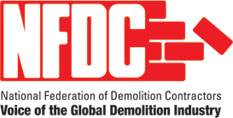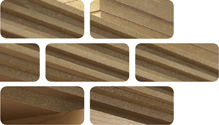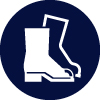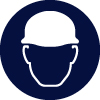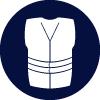
Chipboard Wood 17 02 01
Chipboard is a sheet product produced from wood chips and glues. Chipboard is manufactured in a range of standard sizes of various thicknesses and finishes, depending on the specification required. It is occasionally bound to an insulation panel or includes an insulating film. Some have a finished veneer for use in furniture or as kitchen surfaces. Beware of water damaged sheets that have expanded and are weakened.
Usage & Probable Locations
Personal Protective Equipment
PPE requirements indicated are for guidance purposes only. DRIDS has identified the PPE that is mandatory on all demolition projects and ones that may be required subject to site specific Risk Assessment & Method Statement (RAMS). Hover over the icon to determine the types of PPE required for the removal of this material.
Removal, Segregation & Storage
Depending on how a chipboard sheet has been fitted for use, will determine how it is removed, segregated and stored. Chipboard sheets that are in good condition, not water damaged and not coated with glues will have some reclamation or reuse value. They should be segregated and stored flat on a suitably sized pallet or on timber skids, preferably inside or covered with plastic or tarpaulin sheets to keep them dry. They should also be stored away from plant movements to prevent splash damage or breakage. Chipboard destined for recycling or recovery can be stored in a similar fashion, but is often added to a timber only skip along with other wood and timber items.
Tools
Fixtures, Fittings & Connections
Chipboard floors, roofs and cladding are generally fixed in place with nails, screws, a glue or adhesive. For some wall panel systems, the chipboard sheets will tightly run inside metal, timber or plastic channels without the need for fixings. Flat roof sheets will often be coated with bitumen and felt. Kitchen units will include various types of fixing pins, nails, gromets and dowels. Insulated chipboard panels will have a layer of foam insulation glued to the chipboard sheet. Chipboard raised floor tiles are not fixed in place but are mostly covered in a metal sheet.
Health & Safety
Subject to task-specific Risk Assessment & Method Statement (RAMS). Use correct protective equipment for removing fixings, especially nails and screws. Wear gloves when handling sheets with damaged edges, coated in bitumen or adhesives to prevent irritation, cuts and splinters. Wear eye protection when removing nails with a crowbar, hammer or nailbar. Do not walk on wet and slippery sheets that are painted or coated in vinyl, metal, formica or other type of veneer.
